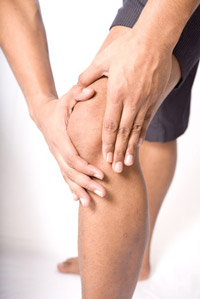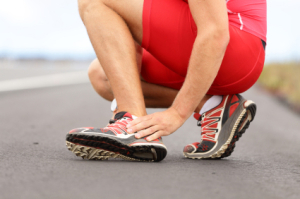 Most musculoskeletal conditions are caused by overuse. Conditions of the foot and knee are no different. We diagnose these conditions in western medicine with names like plantar fasciitis, torn meniscus, arthritis, Achilles tendonitis, IT band syndrome, patella-femoral syndrome, bunions, runner’s knee, and more.
Most musculoskeletal conditions are caused by overuse. Conditions of the foot and knee are no different. We diagnose these conditions in western medicine with names like plantar fasciitis, torn meniscus, arthritis, Achilles tendonitis, IT band syndrome, patella-femoral syndrome, bunions, runner’s knee, and more.
These conditions all start with a mechanism of overload, which is a muscular weakness away from the site of pain that is causing the painful tissue to be overloaded. The mechanism of overload combined with overuse over time creates chronic and progressive injuries.
The Traditional Approach
Traditional medicine often sees these conditions as isolated problems of localized traumatized tissue. Treatment is focused on the painful area and ends when the pain is gone. Treatments of choice are frequently rest and medications to mask or reduce pain. Like perfume on a pig, when the medication wears off or activity resumes, the pain returns. More often than not, this leads to surgical intervention, which may not relieve the problem.
The [CORE] Approach
At [CORE] Chiropractic & Wellness Center, we see the body as a whole and take to heart the wisdom of Dr. Karl Lewitt, who said, “He who looks at the site of pain is lost.” This famous saying underlies the following approach of our office.
1. Understand the mechanism of overload.
2. Reduce the mechanism of overload.
3. Improve joint stability.
4. Reduce pain and inflammation.
5. Improve the healing rate of the body.
Understand the Mechanism of Overload
To say that the biomechanics of the foot and knee are complex is an understatement. Thirty bones comprise each leg and foot along with 36 joints and more than 100 muscles. The knee and foot are engineering marvels in both flexibility and stability, however they do not exist in a vacuum. The vast majority of foot and knee problems are the result of hip and core weaknesses. Hip and core weaknesses cause overloading of the lower extremities. When combined with poor balance, overtraining, and/or a sedentary lifestyle, injury will occur.
Screens are used to ascertain biomechanical problems in lower extremity movement. Gait analysis, squat and lunge testing, the one-leg balance test, and the one-leg step down are common tests to assess lower extremity problems. These tests don’t show where the pain is located. Instead, they show why the area of pain is being overloaded so that the real problem can be addressed.
Reduce the overloading mechanism
Once the overloading mechanism has been observed and diagnosed, treatment can begin. Treatment in the form of Active Release Technique®, chiropractic manipulation, stretching, etc. are used to reduce the load being placed on the painful tissue. Frequently these treatments work quickly to reduce the problem, but not always the pain. Pain is mostly a chemical reaction and tends to take time to dissipate. (We address this issue in step 4.)
Improve Joint Stability
Improving joint stability starts with reducing the overloading mechanism as stated above, but continues with rehabilitative exercise. Most overloading mechanisms are initiated with the weakness of a muscle far removed from the painful area. These muscles need to be strengthened to improve joint stability.
A well-rounded treatment protocol needs to include exercises to improve hip and core strength to help to spare the stress on the foot and knee. At [CORE] we strive to use functional exercises that resemble activities found in daily life as opposed to exercises only found in the gym. Exercises like squats, lunges, standing on one foot, jump rope, and other specific lower-extremity movements are used to improve joint stability.
Reduce Pain and Inflammation
Part of the [CORE] approach is to directly deal with the pain and inflammation of the foot and knee. We use several tools. The first tool is ice. This simplistic tool is extremely powerful when applied properly. The most effective application of ice is in a Ziploc®-type bag. This application outperforms reusable freezer packs, frozen peas, or anything else.
The second tool is acupuncture. Acupuncture has been used for more than 3,000 years to reduce pain both locally and throughout the entire body. It also improves the body’s rate of healing. The third tool is nutrition. Foods high in antioxidants such as dark-colored fruits and vegetables work to reduce pain and inflammation.
Improve the Healing Rate of the Body
Muscle repair needs a host of nutrients, none more important then L-glutamine. L-glutamine is the most common amino acid in skeletal muscle and is required in times of stress. L-glutamine is frequently used in major rehabilitation hospitals to jumpstart the recovery process after injury. It’s most important for athletes and for those with a history of a poor diet.
Fish or flax oil is also an important tool for the healing of joints and tendons. The omega-3 fats found in fish and flax oils have an anti-inflammatory effect on injured tissues plus the components needed to rebuild healthy cell membranes. These fats are needed for healthy cartilage and to prevent arthritic damage. Fish and flax oil can also be used to help you lose body fat, to build stronger muscles, to improve insulin stability and metabolism, and to reduce your chances of developing cancer.
Daryl C. Rich, DC, CSCS, ART®







